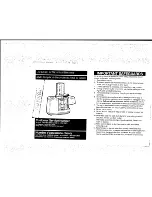
page 1 – 7
FM-531HD / May 2013
G E N E R A L I N F O R M A T I O N
Where to Install the FM-531HD
The best location to install the FM‑531HD is at the transmitter site. This requires that
a discrete Left/Right STL, either analog or digital, be involved in the signal path. The
major benefit of a transmitter site installation is that it enables the use of the FM‑531HD’s
built‑in lab‑grade stereo encoder which allows tighter control of modulation peaks.
A transmitter site location for the processor has the additional benefit of allowing
the use of the FM‑531HD’s highly oversampled composite processor for an additional
loudness advantage. The composite clipper algorithm of the FM‑531HD is much cleaner
and more forgiving than those in other products, and in combination with the tight pilot
and SCA protection filters can create additional loudness without the audible grunge
that composite clippers typically create.
We recommend that whenever there is a choice between using an exciter’s com‑
posite MPX or AES3 input the processor (any processor) should be interfaced to the
transmitter using the exciter’s composite stereo multiplex input. The exciter’s AES3
digital input may be “clean” and it may be “digital”, but it also precludes the ability to
gain additional loudness through the use of the FM‑531HD’s intelligent oversampled
composite clipper. Also, depending on factors including the sample rates being used the
exciter’s AES digital input can exhibit inferior peak control compared to the exciter’s
composite input.
When the processor is located at the studio and an STL is being used to send the
program material to the transmitter site there are several issues to consider:
Analog Left/Right STL
Older analog discrete left/right STL’s can suffer from an inability to control audio
peaks because of inadequate bandwidth in their IF circuits and/or poor low frequency
and phase performance. Individual left/right STL’s rarely have identical group delay
and this will adversely affect stereo separation when the signal is finally converted to
the multiplex composite domain. Such STL’s can also suffer from AFC bounce when
handling highly processed low frequency material and this can rob modulation capabil‑
ity and therefore reduce on‑air loudness.
Composite Analog STL
A high quality analog composite STL can have advantages over an analog left/right
STL and can typically have broader audio bandwidth and better audio performance
than analog discrete STL’s. Most even have the capability to also piggyback subcarriers
such as SCA and RDS along with the composite audio. This means that most SCA and
RDS generators may also be located at the studio end of the STL, which, along with
the audio processor, makes for a very convenient setup. With a modern composite STL
and properly engineered point‑to‑point path, the audio can be nearly as transparent as
a digital STL.
Analog Phone Lines
Discrete left/right analog “phone line” STL’s are not recommended because of the
inability of most Telco service providers to meet the flat frequency response and phase
matching requirements of the pair of audio circuits. Furthermore, in many countries
wideband analog circuits have become unavailable or their cost prohibitive. On the other
hand if the “wired” STL is a dedicated (and equalized if necessary) pair of circuits that
is under the station’s full control they may be acceptable.
Summary of Contents for FM-531 HD
Page 2: ...Technical Manual Wheatstone Corporation May 2013 FM HD Digital Audio Processor FM 531hd...
Page 122: ...page A 2 FM 531HD May 2013 A P P E N D I C E S Appendix A General Specifications A 3 Contents...
Page 128: ...page A 8 FM 531HD May 2013 A P P E N D I C E S Appendix B FM 531HD GPI Interface A 9 Contents...
















































